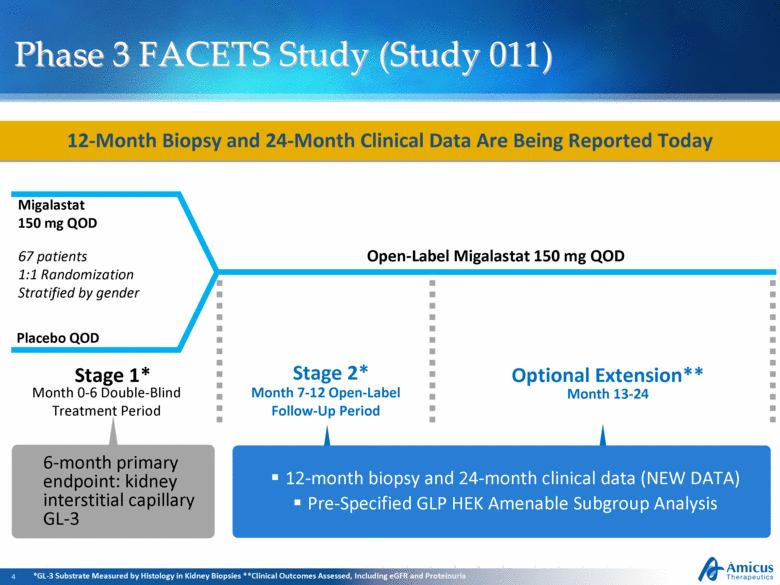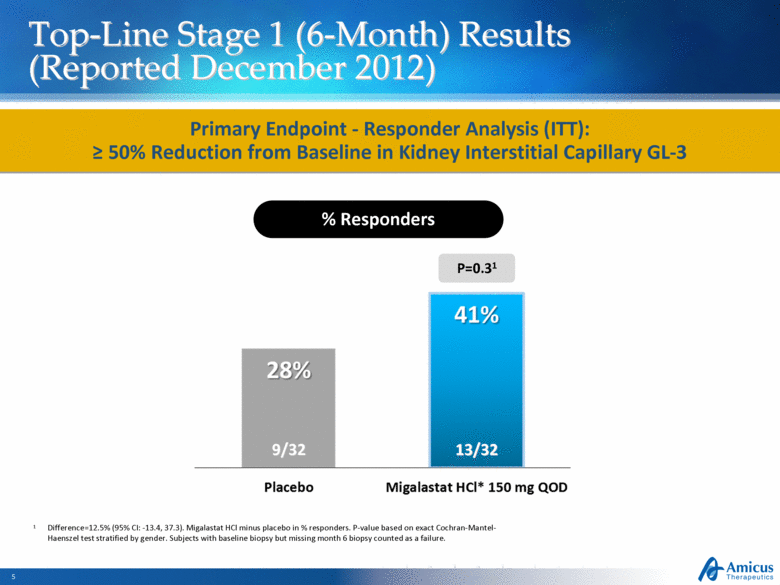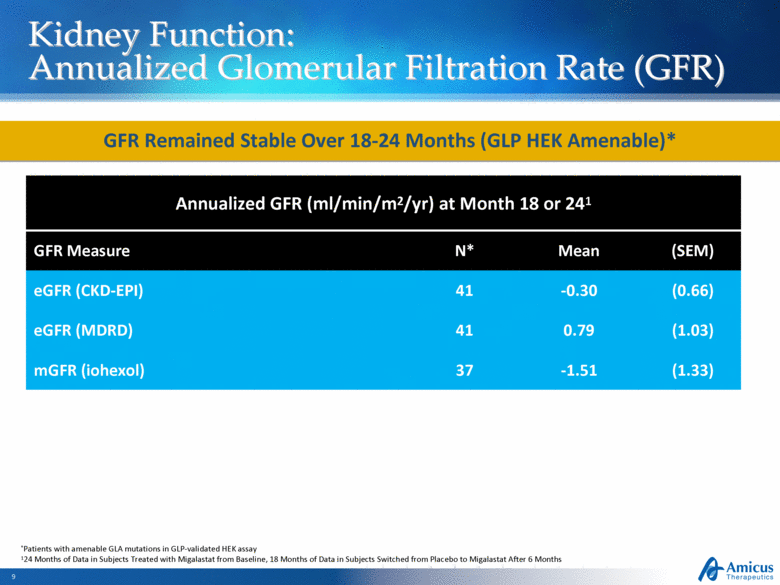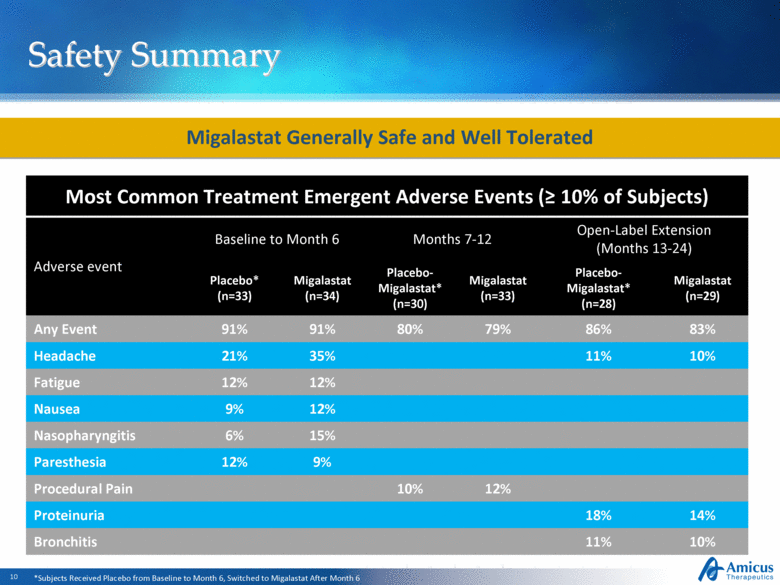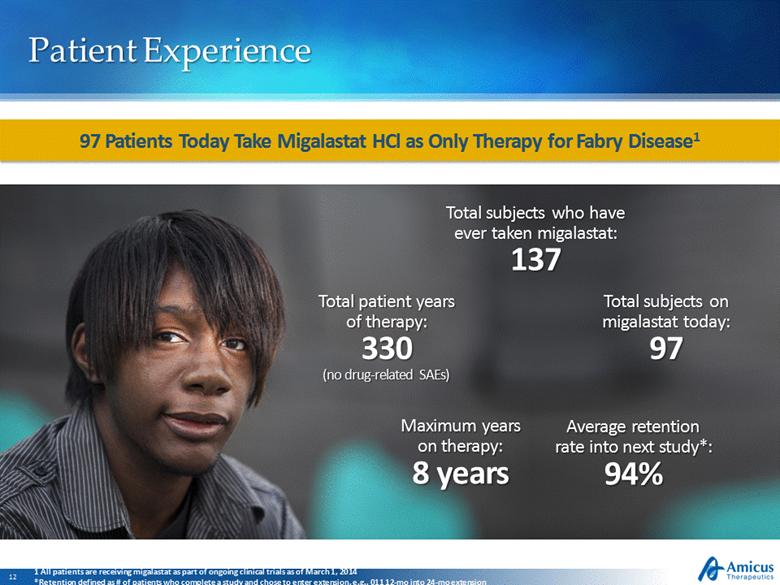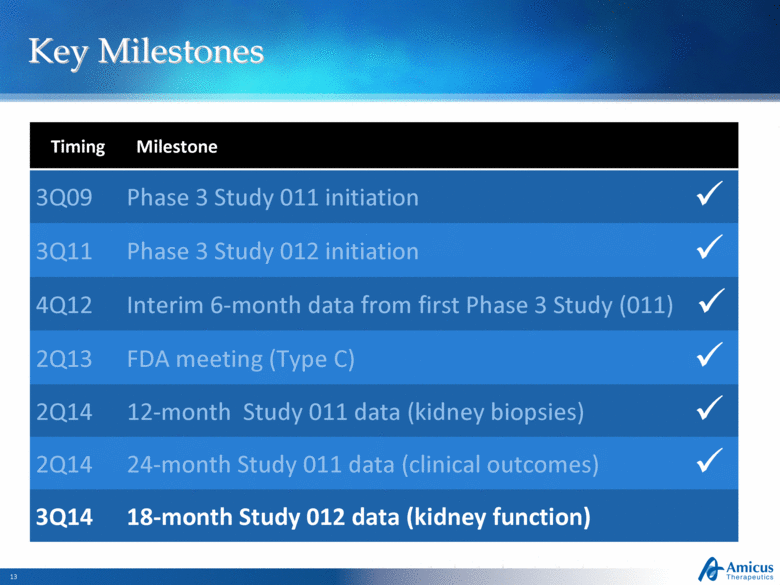Attached files
| file | filename |
|---|---|
| 8-K - 8-K - AMICUS THERAPEUTICS, INC. | a14-11418_18k.htm |
| EX-99.2 - EX-99.2 - AMICUS THERAPEUTICS, INC. | a14-11418_1ex99d2.htm |
Exhibit 99.1
|
|
Phase 3 Fabry Monotherapy Study (Study 011) Results Conference Call April 29, 2014 |
|
|
Safe Harbor This presentation contains “forward-looking statements” within the meaning of the Private Securities Litigation Reform Act of 1995 relating to business, operations and financial conditions of Amicus including but not limited to preclinical and clinical development of Amicus’ candidate drug products, cash runway, ongoing collaborations and the timing and reporting of results from clinical trials evaluating Amicus’ candidate drug products. Words such as, but not limited to, “look forward to,” “believe,” “expect,” “anticipate,” “estimate,” “intend,” “plan,” “would,” “should” and “could,” and similar expressions or words, identify forward-looking statements. Although Amicus believes the expectations reflected in such forward-looking statements are based upon reasonable assumptions, there can be no assurance that its expectations will be realized. Actual results could differ materially from those projected in Amicus’ forward-looking statements due to numerous known and unknown risks and uncertainties, including the “Risk Factors” described in our Annual Report on Form 10-K for the year ended December 31, 2013. All forward-looking statements are qualified in their entirety by this cautionary statement, and Amicus undertakes no obligation to revise or update this presentation to reflect events or circumstances after the date hereof. |
|
|
Study 011 12- and 24-Month Data - Key Findings Subjects who switched from placebo to migalastat after month 6 demonstrated a statistically significant reduction in kidney interstitial capillary GL-3 at month 12 (p=0.013*) Subjects who remained on migalastat for 12 months demonstrated a durable reduction in kidney interstitial capillary GL-3 Reduction in disease substrate also observed in plasma lyso-Gb3 in subjects who switched from placebo to migalastat (p<0.0001**). Subjects who remained on migalastat demonstrated a durable reduction in lyso-Gb3 Kidney function (estimated glomerular filtration rate (eGFR), iohexol mGFR) remained stable over 18-24 months Migalastat was generally safe and well-tolerated Of 41 subjects with GLP HEK amenable mutations who completed Study 011, 35 (85%) remain in voluntary extension study (Study 041) Migalastat Demonstrated Statistically Significant and Durable Substrate Reductions on 12-Month Pre-Specified Primary Analysis in Fabry Patients with Amenable Mutations *MMRM, **ANCOVA |
|
|
Phase 3 FACETS Study (Study 011) 67 patients 1:1 Randomization Stratified by gender Month 7-12 Open-Label Follow-Up Period Month 13-24 Placebo QOD Migalastat 150 mg QOD Open-Label Migalastat 150 mg QOD Slide 4 Month 0-6 Double-Blind Treatment Period Stage 1* Stage 2* Optional Extension** 12-Month Biopsy and 24-Month Clinical Data Are Being Reported Today *GL-3 Substrate Measured by Histology in Kidney Biopsies **Clinical Outcomes Assessed, Including eGFR and Proteinuria 6-month primary endpoint: kidney interstitial capillary GL-3 12-month biopsy and 24-month clinical data (NEW DATA) Pre-Specified GLP HEK Amenable Subgroup Analysis |
|
|
1 Difference=12.5% (95% CI: -13.4, 37.3). Migalastat HCl minus placebo in % responders. P-value based on exact Cochran-Mantel-Haenszel test stratified by gender. Subjects with baseline biopsy but missing month 6 biopsy counted as a failure. P=0.31 9/32 13/32 Top-Line Stage 1 (6-Month) Results (Reported December 2012) Primary Endpoint - Responder Analysis (ITT): > 50% Reduction from Baseline in Kidney Interstitial Capillary GL-3 % Responders |
|
|
6-Month Post-Hoc Analysis (Reported February 2014) Statistically Significant Mean Change in Kidney Interstitial Capillary GL-3 Compared to Placebo (GLP HEK Amenable)* Mean Inclusions Per Capillary1 Baseline Month 6 +0.07 ± 0.13 -0.25 ± 0.10 P=0.0082 *All patients with evaluable paired biopsies and amenable GLA mutations in GLP-validated HEK assay – post hoc at month 6 and pre-specified at month 12 1Data points are baseline corrected; represent mean ± standard error (SEM) change from baseline in the mean number of GL-3 inclusions per capillary after 6 months of treatment with migalastat or placebo. 2Analysis of covariance (ANCOVA) model with covariate adjustment for baseline value and factors for treatment group and treatment by baseline interaction. P-value corresponding to least-square mean difference between migalastat and placebo is displayed. 0.4 0.0 -0.2 -0.4 0.2 Migalastat (n=25) Placebo (n=20) |
|
|
12-Month Pre-Specified Primary Analysis Statistically Significant Mean Change in Kidney Interstitial Capillary GL-3 in Patients Switching from Placebo to Migalastat HCl (GLP HEK Amenable)* Mean Inclusions Per Capillary1 Baseline Month 6 +0.07 ± 0.13 -0.25 ± 0.10 P=0.0082 *All patients with evaluable paired biopsies and amenable GLA mutations in GLP-validated HEK assay – post hoc at month 6 and pre-specified at month 12 1Data points are baseline corrected; represent mean ± standard error (SEM) change from baseline in the mean number of GL-3 inclusions per capillary after 6 months of treatment with migalastat or placebo. 2Analysis of covariance (ANCOVA) model with covariate adjustment for baseline value and factors for treatment group and treatment by baseline interaction. P-value corresponding to least-square mean difference between migalastat and placebo is displayed. 3MMRM Pbo change M6 to M12. Month 12 -0.31 ± 0.10 +0.01 ± 0.011 P=0.0133 0.4 0.0 -0.2 -0.4 0.2 Placebo -> Migalastat (n=17) Migalastat -> Migalastat (n=25,22) Placebo (n=20) |
|
|
Disease Substrate in Plasma (Plasma Lyso-GB3) Statistically Significant Reduction in Plasma Lyso-GB3 at Month 6 and Month 12 Following Treatment with Migalastat (GLP HEK Amenable)* 5.0 -5.0 -10.0 -15.0 10.0 Plasma Lyso-GB31 Baseline Month 6 +0.60 ± 2.4 -11.2±4.8 P=0.00332 -20.0 0.0 *Patients with amenable GLA mutations in GLP-validated HEK assay 1Baseline corrected. Error bars are SEM 2ANCOVA comparing migalstat to placebo in Stage 1 3ANCOVA comparing change from month 6 to month 12 in subjects switching from placebo to migalastat Month 12 +1.2 ±1.3 P<0.00013 Placebo -> Migalastat (n=13) Migalastat -> Migalastat (n=18,18) -15.5±6.2 Placebo (n=13) -25.0 |
|
|
GFR Remained Stable Over 18-24 Months (GLP HEK Amenable)* Annualized GFR (ml/min/m2/yr) at Month 18 or 241 GFR Measure N* Mean (SEM) eGFR (CKD-EPI) 41 -0.30 (0.66) eGFR (MDRD) 41 0.79 (1.03) mGFR (iohexol) 37 -1.51 (1.33) Kidney Function: Annualized Glomerular Filtration Rate (GFR) *Patients with amenable GLA mutations in GLP-validated HEK assay 124 Months of Data in Subjects Treated with Migalastat from Baseline, 18 Months of Data in Subjects Switched from Placebo to Migalastat After 6 Months |
|
|
Safety Summary Most Common Treatment Emergent Adverse Events (> 10% of Subjects) Adverse event Baseline to Month 6 Months 7-12 Open-Label Extension (Months 13-24) Placebo* (n=33) Migalastat (n=34) Placebo-Migalastat* (n=30) Migalastat (n=33) Placebo-Migalastat* (n=28) Migalastat (n=29) Any Event 91% 91% 80% 79% 86% 83% Headache 21% 35% 11% 10% Fatigue 12% 12% Nausea 9% 12% Nasopharyngitis 6% 15% Paresthesia 12% 9% Procedural Pain 10% 12% Proteinuria 18% 14% Bronchitis 11% 10% Migalastat Generally Safe and Well Tolerated *Subjects Received Placebo from Baseline to Month 6, Switched to Migalastat After Month 6 |
|
|
Global Regulatory Strategy Totality of clinical data 8+ years of data in extension studies Complete data from Phase 3 Studies (011 and 012) Clear regulatory pathway Non-inferiority to ERT (Study 012) |
|
|
Patient Experience 97 Patients Today Take Migalastat HCl as Only Therapy for Fabry Disease1 1 All patients are receiving migalastat as part of ongoing clinical trials as of March 1, 2014 *Retention defined as # of patients who complete a study and chose to enter extension, e.g., 011 12-mo into 24-mo extension Total subjects on migalastat today: 97 Total patient years of therapy: 330 (no drug-related SAEs) Maximum years on therapy: 8 years Average retention rate into next study*: 94% Total subjects who have ever taken migalastat: 137 |
|
|
Key Milestones Timing Milestone 3Q09 Phase 3 Study 011 initiation 3Q11 Phase 3 Study 012 initiation 4Q12 Interim 6-month data from first Phase 3 Study (011) 2Q13 FDA meeting (Type C) 2Q14 12-month Study 011 data (kidney biopsies) 2Q14 24-month Study 011 data (clinical outcomes) 3Q14 18-month Study 012 data (kidney function) |




